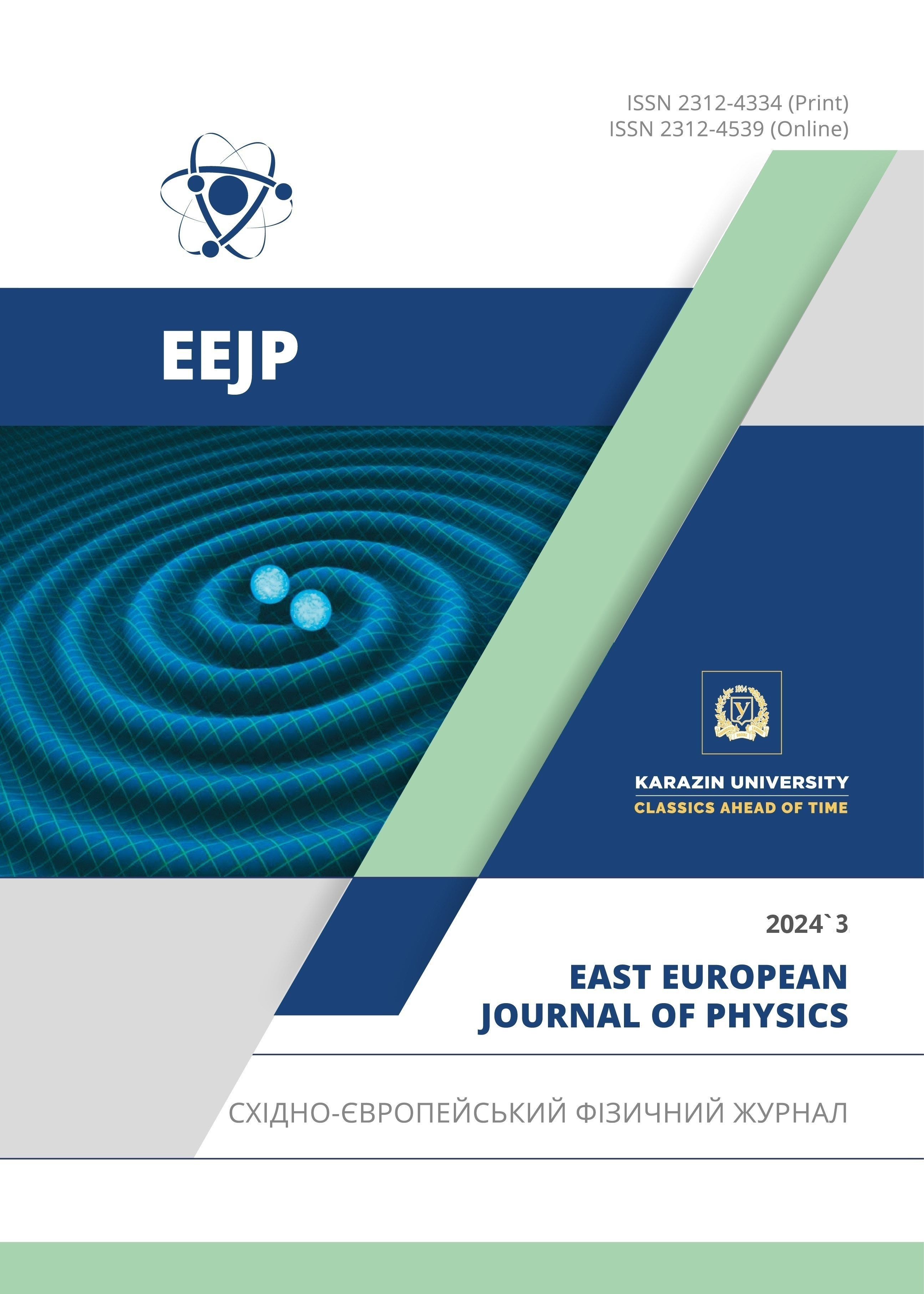Механізм передачі струму в гетероструктурах n-GaAs – p(ZnSe)1-x-y(Ge2)x(GaAs1–δBiδ)y
Анотація
Вольт-амперні характеристики (ВАХ) гетероструктур n-GaAs–p(ZnSe)1–x–y(Ge2)x(GaAs1–δBiδ) демонструють характерний квадратичний закон – ВАХ J~V2 з різким зростанням передпробійного струму, що добре пояснює спостережувану пряму гілку ВАХ, і ця закономірність залишається незмінною при різних температурах. Аналіз ВАХ гетероструктур n‑GaAs‑ p‑(ZnSe)1‑x‑y(Ge2)x(GaAs1–δBiδ) з протяжним проміжним шаром твердого розчину показує, що при прямому зміщенні переважає дрейфовий механізм переносу заряду.
Завантаження
Посилання
V.P. Makhni, M.M. Sletov, and I.V. Tkachenko, “The nature of the green luminescence band in zinc selenide crystals,” Journal of Optical Technology, 74(6), 394-396 (2007). https://doi.org/10.1364/JOT.74.000394
V.P. Makhni, M.M. Sletov, and S.V. Khusnutdinov, “Preparation of ZnO Heterolayers on Zinc Chalcogenide Substrates,” Inorganic Materials, 43(12) 1304–1306 (2007). https://doi.org/10.1134/S0020168507120096
V.P. Makhniy, M.M. Slyotov, and S.V. Khusnutdinov, “Luminescence of zinc oxide layers synthesized on zinc selenide substrates by the isovalent substitution method,” Russian Physics Journal, 52(2), 216-217 (2009).
A. Gangopadhyay, “Investigation of Strain Relaxation Mechanisms and Interfacial Defects in Lattice-mismatched GaAs(001)-based Heterostructures,” PhD Thesis, Arizona State University, May 2021, pp.136.
L.G. Wang, and A.Z. Dilute, “Dilute nonisovalent (II-VI)-(III-V) semiconductor alloys: Monodoping, codoping, and cluster doping in ZnSe-GaAs,” Physical Review B, 68, 125211 (2003). https://doi.org/10.1103/PhysRevB.68.125211
A.Y. Boboev, “Structural features, electrophysical and photoelectric properties of n- (GaAs)-p-GaAs)1-x-y(Ge2)x(ZnSe)у heterostructures,” PhD Thesis, Tashkent, IFPM, 2019, 128 p.
S. Zainabidinov, Sh. Utamuradova, and A. Boboev. “Structural Peculiarities of the (ZnSe)1–x–y(Ge2)x(GaAs1–δBiδ)y Solid Solution with Various Nanoinclusions,” Journal of Surface Investigation X-ray Synchrotron and Neutron Techniques, 16(6),1130-1134 (2022). https://doi.org/10.1134/S1027451022060593
S. Zaynabidinov, A. Saidov, A. Boboev, and D. Abdurahimov, “Structure, Morphology and Photoelectric Properties of n-GaAs-p-(GaAs)1--x(Ge2)х Heterostructure,” Herald of the Bauman Moscow State Technical University, Series Natural Sciences, 100(1), 72-87 (2022). https://doi.org/10.18698/1812-3368-2022-1-72-87
O.O. Mamatkarimov, O. Himmatkulov, and I.G. Tursunov, “Effect of Uniaxial Elastic Deformation on the Current–Voltage Characteristic of Surface-Barrier Sb–p-Si〈Mn〉–Au Diodes,” Semiconductors, 54(5), 563–566 (2020). https://doi.org/10.1134/S1063782620050085
A.S. Saidov, A.Yu. Leiderman, Sh.N. Usmonova, and U.P. Asatova, “Peculiarities of the Current–Voltage Characteristic of n-GaP–p-(InSb)1–x(Sn2)x Heterostructures,” Technical Physics Letters, 46(11), 1124–1127 (2020). https://doi.org/10.1134/S1063785020110279
A.Yu. Leiderman, and M.K. Minbaev, “A mechanism of rapid growth of direct in semiconductor diode structures,” FTP, 30(10), 1729-1738 (1996). (in Russian)
Sh.A. Mirsagatov, A.Yu. Leiderman, and O.K. Ataboev. “Mechanism of Charge Transfer in Injection Photodiodes Based on the In–n+CdS–nCdSxTe1–x–pZnxCd1–xTe–Mo Structure,” Physics of the Solid State, 55(8), 1635–1646 (2013). https://doi.org/10.1134/S1063783413080192
A.Yu. Leiderman, and P.M. Karageorgy-Alkalaev, “On the theory of sublinear current-voltage characteristics of semiconductor structures,” Solid State Communications, 25(10), 781-783 (1978). https://doi.org/10.1016/0038-1098(78)90239-9
P.M. Karageorgy-Alkalaev, and A.Yu. Leiderman, “Statistics of Inter-Impurity Recombination of Electrons and Holes in Semiconductors,” Physica status solidi (b). 26(2), 419-428 (1968). https://doi.org/10.1002/pssb.19680260204
A.Yu. Leiderman, “Possible Influence of Nonequilibrium Carrier Recombination Rate Saturation on Photocell Operation,” Applied Solar Energy, 44(2), 79–81 (2008). https://doi.org/10.3103/S0003701X08020035
Авторське право (c) 2024 Сіражідін С. Зайнабідінов, Хотамжон Дж. Мансуров, Акрамжон Ю. Бобоєв, Джахонгір Н. Усмонов

Цю роботу ліцензовано за Міжнародня ліцензія Creative Commons Attribution 4.0.
Автори, які публікуються у цьому журналі, погоджуються з наступними умовами:
- Автори залишають за собою право на авторство своєї роботи та передають журналу право першої публікації цієї роботи на умовах ліцензії Creative Commons Attribution License, котра дозволяє іншим особам вільно розповсюджувати опубліковану роботу з обов'язковим посиланням на авторів оригінальної роботи та першу публікацію роботи у цьому журналі.
- Автори мають право укладати самостійні додаткові угоди щодо неексклюзивного розповсюдження роботи у тому вигляді, в якому вона була опублікована цим журналом (наприклад, розміщувати роботу в електронному сховищі установи або публікувати у складі монографії), за умови збереження посилання на першу публікацію роботи у цьому журналі.
- Політика журналу дозволяє і заохочує розміщення авторами в мережі Інтернет (наприклад, у сховищах установ або на особистих веб-сайтах) рукопису роботи, як до подання цього рукопису до редакції, так і під час його редакційного опрацювання, оскільки це сприяє виникненню продуктивної наукової дискусії та позитивно позначається на оперативності та динаміці цитування опублікованої роботи (див. The Effect of Open Access).








